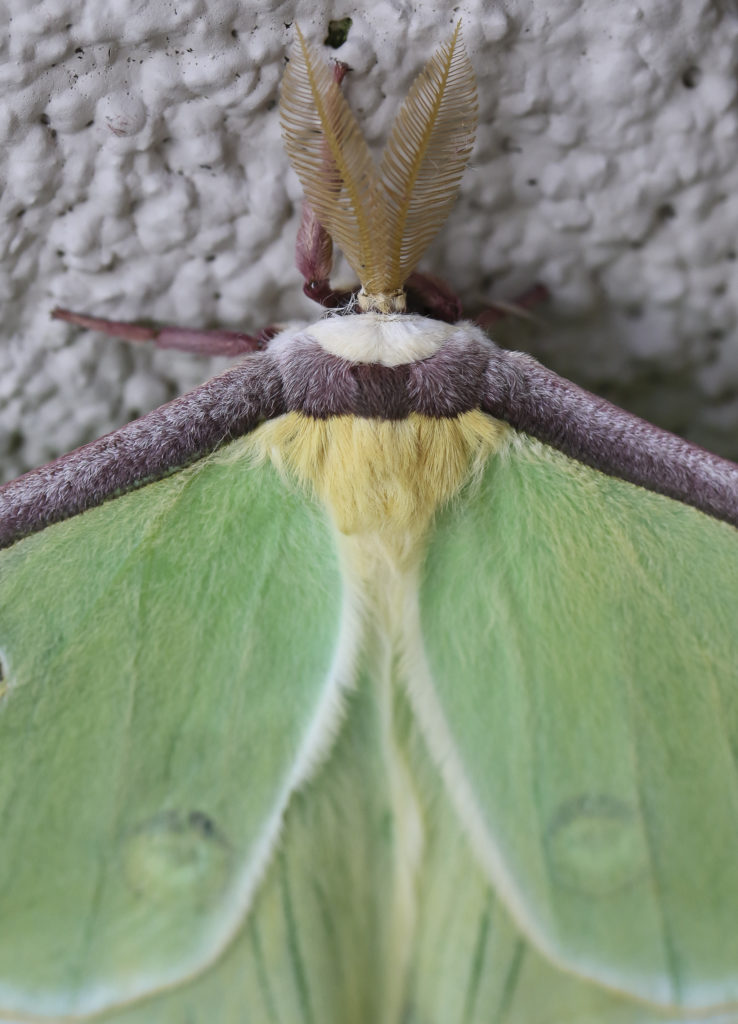Luna Moths: Jewels of the Night

By Wayne Bierbaum
When I was about 8 years old, my family took a rustic vacation to a cabin located on the banks of Blue Run, the river formed by the Silver Springs in Florida.
Silver Springs pours out 70-degree water year-round and is known for its clear water and was used for the making of six Johnny Weissmuller Tarzan movies. Because of swimming, fishing, exploring and the wildness of the land, I enjoyed that vacation immensely. Yet one thing that I remember most about that vacation was a remarkable animal early one morning.
I have always been an early riser, which probably stressed out my parents, as I would wake up to read or explore before the sun came up, around 5:30 a.m. in the summer. When we were on vacation, I got up even earlier.
On the second day of this particular vacation, I woke up early because the riverside was so noisy with animal sounds. It was a damp morning and as the sun started to come up, there was dew sparkling everywhere, on the grasses, on the leaves and all around. As I walked to the edge of the river, hanging on a tall, thick clump of grass was a giant green moth. The biggest moth I had ever seen, sparkling with droplets of dew. I still remember how excited and stunned I was to find this jewel of a creature. I got everyone up to show them. My father, who had been a state park ranger, explained that it was a Luna moth and that it would be alive for about a week—I think my family went back to bed after that. Each time I see a Luna moth I remember that first magical encounter.
Luna moths are one of the largest moths in North America. They have a wingspan of 3 to (rarely) 7 inches. They are a species of silk moths that weaves a silky thread cocoon around itself as it goes from caterpillar to pupa stage. They are only found in North America and are uncommon west of the Mississippi River. The name is derived from Luna, the Roman moon goddess.
The caterpillar lives off the leaves of certain deciduous trees; white birch, hickory, sweet gum and persimmon. There are five stages of growth for the caterpillar to reach pupa stage. In the southern range, Luna moths develop, from egg to adult, in about 9 weeks. They can go through three generations in a year. In their northern range, they go through one life cycle a year and the pupa form spends 9 months hidden in leaf litter over the winter to then emerge as an adult in the spring.
The female adult moths attach themselves to trees suitable for hungry caterpillars and at night attract males with their pheromones. After mating, the moths lay their eggs throughout the tree and in 7 to 10 days, the eggs hatch. Within a week, the adult dies.
There are two interesting features of adult moths. The first is that they have no mouthparts and do not feed or drink at all during their week of having wings. The second feature is that they have long fluttering tails on their wings. Research shows that the moth’s primary predator, bats, find it difficult to echolocate the moths with the tails attached. The bats were almost 100 percent accurate in capturing them when the tails were removed versus 65 percent with tails.
Luna moths are common in our area in early to mid-June and are attracted to lights at night. Their sightings do seem to coincide with the full moon. Hopefully, you will get to see this green jewel of the night skies.
